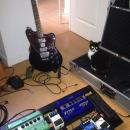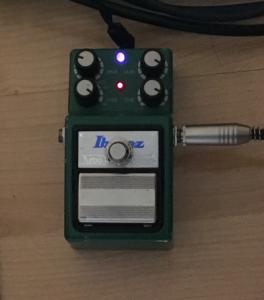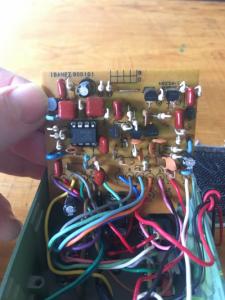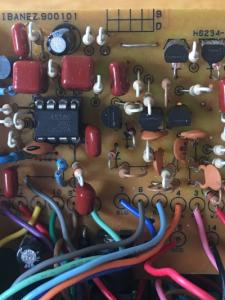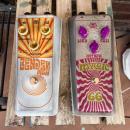Muy buenas compañeros,
acudo al foro en búsqueda de vuestra sabiduría.
Hace un par de años compré este TS9Dx a un compañero del foro. En el anuncio lo publicaba como "Keeley MOD Tube Screamer", pero el precio era de TS9Dx normal de segunda mano. A sabiendas de que probablemente no era un Keeley (de entrada, no lleva la palanca de 3 posiciones), y dado que necesitaba un TS por aquel entonces, lo compré.
Ojo, estoy muy contento con él. Es un pedalazo. De hecho me suena "mejor" que el no-modificado (comparado con otro TS9Dx de serie). La consulta es para saber quién es el autor de esta maravilla.
Mods a simple vista:
- Se le ha añadido un switch adicional al pulsador cuadrado. Ambos funcionan, siendo el cuadrado el clásico para activar el pedal, y el switch un treble boost.
- Se le ha añadido un led rojo, que se ilumina cuando el treble boost entra en funcionamiento.
- El Led normal (de los dos, el de arriba) es de un color MORADO-VIOLETA.
- Y tiene algo más de salida cuando el gain está a su nivel mínimo. De hecho, aún al mínimo, rompe más poco la señal que un TS9Dx de serie.
Mirando la placa, no veo modificaciones que sepa reconocer. Está el chip 4558D típico.
Dicho esto. ¿Alguien sabría identificar qué tenemos entre manos?
De antemano, mil gracias por la atención y la ayuda.
Archivos adjuntos (
loguéate para descargar)

¿Alguien puede iluminarme con su sapiencia?

Muy complicado para mí reconocerlo de golpe en una foto. La mod de Keeley es principalmente cambiar unos componentes por otros, ese switch adicional para el treble boost no se si es de Keeley o cosecha propia de quién hizo la otra mod. Me parece ver un jumper en la parte superior de la foto, es decir que se ha eliminado un componente, que yo sepa la mod clñasica era cambiar unos componentes por otros, no se leminaba ninguno...
También es posible que cualquiera que haga una mod diga que es la Keeley porque así le da mejor salida al pedal, que no digo que sea el caso.
Te paso el siguiente texto en el que el propio Keeley explicaba en su web en qué consiste su mod, debería llevar una imagen con el circuito, pero no la tengo:
The Art of TS9 Modifications
Musicians Hotline is proud to premier a new monthly column from Robert Keeley of Keeley Effects, entitled Pedal Power. Learn the art of pedal mods, set up and maintenance tips to get the most out of your pedal. Power to the PEDAL BROTHER!
There are several nice things about modding effect pedals. First of all they don't involve lethal voltages and generally they are inexpensive if a worst-case scenario happens! Time to dig that TS9 out of the closet that you have replaced with a modern interpretation and install some new life. This is akin to installing a carburetor, intake manifold and camshaft; tools are required and it takes a bit of work to make it growl! In this article we will look at some simple mods for the Ibanez TS9.
I had the pleasure of working on Peter Frampton's TS808. I did feel a little strange tearing into a collector's piece but this was something he wanted improved so that it didn't have the bass loss and degradation in tone he had found over time.
Take out your TS9 and say "Ohayo Gozaimasu" (Good Morning in Japanese). Then say "Soyonara warui oto" (Bye bad tone). What we are specifically saying goodbye to is the bass frequency roll off and the 3rd order harmonics from the electrolytic caps. So, get your soldering iron, solder, and solder wick. Radio Shack part numbers 64-2802, 64-007, and 64-2090 respectively. The solder wick is used to take off the original solder. You place the wick on the old solder joint and then press the hot iron against the wick to remove the old solder. You should see the solder slowly pull the wick away until just the lead is visible. Then you can remove the old part. Be careful with your soldering iron. If any process takes you longer than 5 seconds or so, wait and let the area completely cool. You should strive for doing nice, shinny solder connections in about 2 seconds so heat damage will not occur. You may even want to try soldering and de-soldering on an old radio or broken effect pedal to practice a few times.
The part we want to remove is the capacitor that controls the bass roll-off. This high-pass filter is controlled by the capacitor that is located right above wire markers 10 and 11 on the circuit board. It will generally be a yellow cap that is marked 473. That is 0.047uF (marked "A" in the picture). We are going to replace it with a 0.1uF capacitor. Radio Shack part number 272-1053 for the metal film type if you want to go fancy, and 272-1069 if you want the same quality Ibanez uses, which is fine for what we are doing here. It is the new value we are most interested in. To increase the amount of drive or saturation this pedal can achieve while we are in this area, change the resistor between marker 13 and 11 (just above and a little to the left of the cap we just changed). Change this 4.7k-ohm resistor (marked "B" in the picture) to a lower value; say 2.2k-ohm, RadioShack part number 271-1325. Better yet get an assortment pack from them so you can experiment with lower values to get even more horsepower, err..distortion! Now look at the other side of the IC (the chip or op-amp depending on what part of town you're from!). There are two little can-type capacitors. They 're blue-black in color and have the markings 1uF on them ("C" in the picture). They are located between wire markers 8 and 9 and the other is between 10 and 11, they are also marked NP on the board so that will help locate them. Replace these with Radio Shack part number 272-1055. Whoa!!! Those are huge! Yes, take some wire and use the plastic insulation for insulation on the legs of these large caps so that nothing touches or shorts out. Or, you can use Digi-key.com part number P4675-ND like we use here at the shop. They fit nicely. These are changed to increase the transparency of the pedal. This is subtle but noticeable. Like putting a new air filter on your car and thinking it drives and handles better!
Bottom line, these changes are things that make a difference. People will notice your better tone. Customers report to me that even the drummer in your band will notice and ask you to turn up a bit! Say "Yumei Onkyo", Famous Sound!

Mil gracias Paco, me ha servido de mucha ayuda.
ese artículo y mucha lupa y linterna del móvil ha arrojado las siguientes conclusiones:
- está hecho la Brown Mod, es decir, cambiar las resistencias R114 y R115 a valores de 100 ohn y 10 K respeectivamente (conviertiéndolo en teoria en un TS808)
- Mirando bien la placa, el IC se ha cambiado seguro al 4558D de los TS808
- También se ha hecho la modificación de Bass Roll Off que mencionaba tu artículo
Entiendo que la mod de mayor gain también se ha hecho, aunque no sé localizarla, porque en su momento comparándolo con otro TS, esta unidad tenia bastante más salida.
Todo apunta a que es la High Gain Baked Mod de Keeley (o al menos, se ha hecho siguiendo sus esquemas).
Mil gracias!


